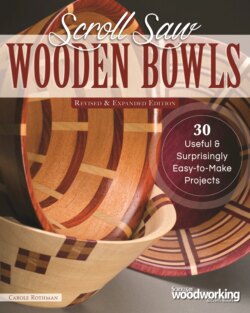Читать книгу Scroll Saw Wooden Bowls, Revised & Expanded Edition - Carole Rothman - Страница 26
Table tilt and cutting direction
ОглавлениеMost scroll saw projects are cut with the saw table perpendicular to the blade. Projects using angle cuts, such as double bevel inlay, relief cutting, and collapsible baskets, typically use small angles, no greater than 4˚. To someone who has never cut at a steep angle, making accurate cuts with the saw table or arm tilted between 15˚ and 45˚ may seem nearly impossible.
If your scroll saw has a tilting table, the instructions will direct you to tilt the left or right side of the table down to a specified angle. Nearly all saws with tilting tables have a full 45˚ tilt to the left but vary in degree of tilt to the right. For this reason, “left side down” has become a convention, although the direction of table tilt will always be specified.
If your saw has a tilting arm, just reverse the direction of the tilt given for the table. “Left side down” for tilting tables is the equivalent of “right side down” for tilting arms.
Cutting a ring in a clockwise direction means that the wood is moving counterclockwise. The cut will be wider on the upper face than on the lower one.
Blade tensioning
1. If blade slippage occurs when using higher tension, the blade ends can be lightly sanded to remove any residual oil. Clamping screws can also be sanded or filed to remove any oil, dirt, or burrs that may be contributing to the problem.
2. The blade holders on some scroll saws require considerable finger strength to tighten sufficiently to prevent slippage. This problem can be solved with an easy-to-make tightener that slips over the knob. To make this simple device, trace the outline of your scroll saw’s blade-holder knob on a small block of wood, drill out the center, and cut along the outline. Be careful not to over tighten to avoid stripping threads or breaking the clamp.
This shop-made device makes it easy to tighten blade holders.
When cuts are made with blade and table perpendicular to each other, cutting direction is a matter of preference. When cuts are made at an angle, direction is critical and always clearly specified in the instructions. Nearly all cuts are made in a clockwise direction. This means that you are rotating the wood counterclockwise as it moves through the blade. In other words, the blade appears to be moving clockwise because the wood is being rotated counterclockwise. A ring cut in this manner, with the saw table tilted left side down, will have a larger diameter on the upper face than on the lower. Those few situations when counterclockwise cutting is needed are indicated clearly in boldface.
Drill holes using the smallest bit that will accommodate your blade. The smaller the hole, the easier the sanding will be later on.
Sanding away drill marks may be tedious, but the alternative—cutting into the ring—leaves permanent cut lines on the sides of the bowl.
